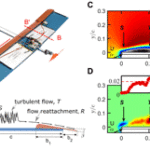Paper: A bioinspired Separated Flow wing provides turbulence resilience and aerodynamic efficiency for miniature drones
Birds and insects have wings with rough leading edges to separate airflow, which assists counterintuitively with easier flight. Scientists have adapted to combat the issue of smaller drones being buffeted by air with a new design: “Separated Flow Airfoil”. Boundary air is the air directly in contact with the surface of the wing, and with larger aircrafts the turbulence keeps the flow attached to the wing, while with smaller aircrafts the boundary air tends to be smooth and laminar, often detaching and causing more drag. Researchers at Brown University have found that a wing design with a sharp leading edge is more aerodynamically effective for smaller drones than the smooth wing contour of aircrafts now. They tested via lift coefficient analysis, wind and water tunnel experiments, and flight power measurements. The new wing design could increase flight time from an average of 30min to an average of 170min.
Learn about our two Decals!
 Click here to find out more about our Fall Bioinspired Design Decal and our Spring Bioinspired Design in Action Decal – ALL MAJORS are welcome.
Click here to find out more about our Fall Bioinspired Design Decal and our Spring Bioinspired Design in Action Decal – ALL MAJORS are welcome.Berkeley BioDesign Community
 Click here to learn about the BioD: Bio-Inspired Design @ Berkeley student organization or here to signup for more info.
Click here to learn about the BioD: Bio-Inspired Design @ Berkeley student organization or here to signup for more info.Search
Student Login





I imagine that the neurological circuits underlying these processes are governed by both 2d spacing maps with their brains as…
to reduce the impact of car accidents, it may be possible to study the force diverting physics of cockroaches to…
you see this type of head-bobbing stability in many avian creatures related to pigeons like chickens. the head ability to…
not like they taught horses how to run! this is an example of convergent evolution where both sea creatures and…
The brain functions in a similar way with neuronal connections. our brains are able to utilize the multiplicity of connections…